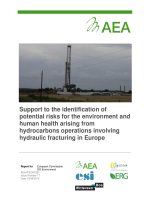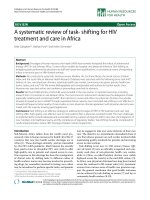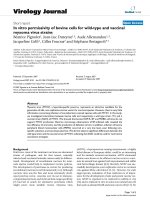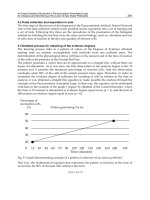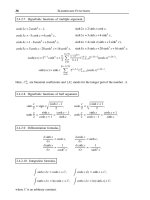Code of Standard Practice for Steel Buildings and Bridges Part 11 ppsx
Bạn đang xem bản rút gọn của tài liệu. Xem và tải ngay bản đầy đủ của tài liệu tại đây (21.25 KB, 4 trang )
impaired.
10.4.2. Unless otherwise specified in the Contract Documents, AESS
members and components shall be plumbed, leveled and aligned to
a tolerance that is one-half that permitted for non-AESS members.
To accommodate these erection tolerances for AESS, the Owner’s
Designated Representative for Design shall specify Connections
between AESS members and non-AESS members, masonry, con-
crete and other supports as Adjustable Items, in order to provide the
Erector with means for adjustment.
When AESS is backed with concrete, the Owner’s Designated
Representative for Construction shall provide sufficient shores, ties
and strongbacks to prevent sagging, bulging or similar deformation
of the AESS members due to the weight and pressure of the wet
concrete.
Code of Standard Practice for Steel Buildings and Bridges, March 7, 2000
AMERICAN INSTITUTE OF STEEL CONSTRUCTION
77
AMERICAN INSTITUTE OF STEEL CONSTRUCTION, INC.
One East Wacker Drive, Suite 3100, Chicago, Illinois 60601-2001
Pub. No. S303 (20M500)
1.1. Scope
1.2. Referenced Specifications, Codes and Standards
1.3. Units
1.4. Design Criteria
1.5. Responsibility for Design
1.6. Patents and Copyrights
1.7. Existing Structures
1.8. Means, Methods and Safety of Erection
2.1. Definition of Structural Steel
2.2. Other Steel, Iron or Metal Items
3.1. Structural Design Drawings and Specifications
Commentary:
Commentary:
3.2. Architectural, Electrical and Mechanical Design Drawings and
Specifications
3.3. Discrepancies
3.4. Legibility of Design Drawings
3.5. Revisions to the Design Drawings and Specifications
3.6. Fast-Track Project Delivery
4.1. Owner Responsibility
4.2. Fabricator Responsibility
4.3. Use of CAD Files and/or Copies of Design Drawings
4.4. Approval
4.5. Shop and/or Erection Drawings Not Furnished by the Fabricator
5.1. Mill Materials
5.2. Stock Materials
6.1. Identification of Material
6.2. Preparation of Material
6.3. Fitting and Fastening
6.4. Fabrication Tolerances
6.5. Shop Cleaning and Painting (see also Section 3.1.6)
6.6. Marking and Shipping of Materials
6.7. Delivery of Materials
7.1. Method of Erection
7.2. Job-Site Conditions
7.3. Foundations, Piers and Abutments
7.4. Building Lines and Bench Marks
7.5. Installation of Anchor Rods, Foundation Bolts and Other
Embedded Items
7.6. Installation of Bearing Devices
7.7. Grouting
7.8. Field Connection Material
7.9. Loose Material
7.10. Temporary Support of Structural Steel Frames
7.11. Safety Protection
7.12. Structural Steel Frame Tolerances
7.13. Erection Tolerances
7.14. Correction of Errors
7.15. Cuts, Alterations and Holes for Other Trades
7.16. Handling and Storage
7.17. Field Painting
7.18. Final Cleaning Up
8.1. General
8.2. Inspection of Mill Material
8.3. Non-Destructive Testing
8.4. Surface Preparation and Shop Painting Inspection
8.5. Independent Inspection
9.1. Types of Contracts
9.2. Calculation of Weights
9.3. Revisions to the Contract Documents
9.4. Contract Price Adjustment
9.5. Scheduling
9.6. Terms of Payment
10.1. General Requirements
10.2. Fabrication
10.3. Delivery of Materials
10.4. Erection


